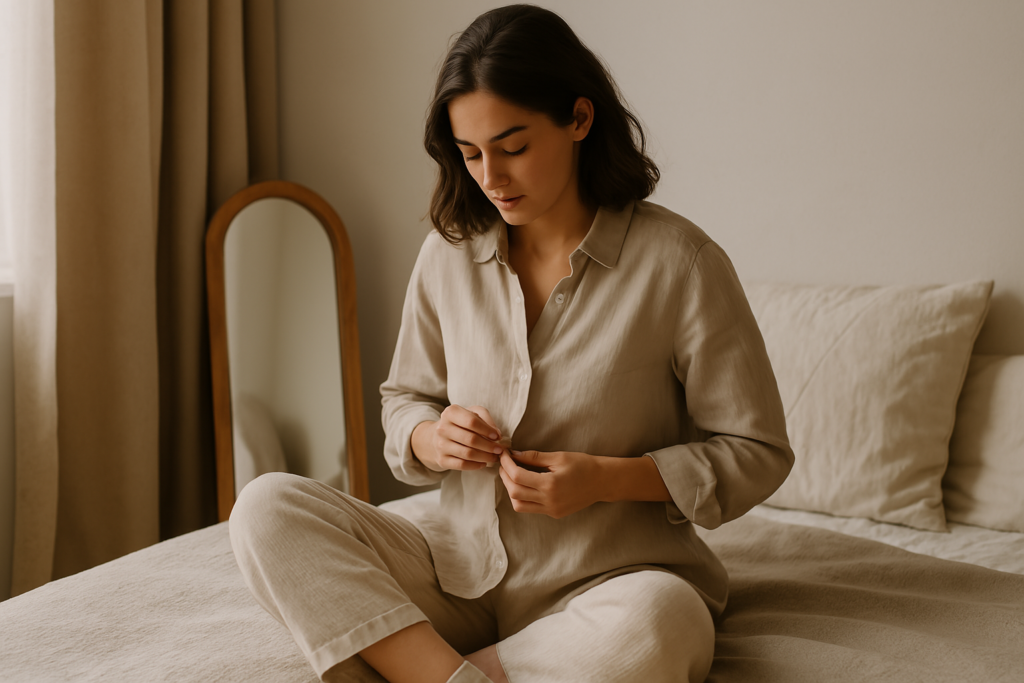Introduction to the Art of Dressing
In our fast-paced lives, the routine of getting dressed is often relegated to a mere obligation, executed with a sense of urgency. Each morning, many of us rise to the sound of alarms, hurriedly tossing on clothes without pausing to consider the significance of this daily ritual. However, by reframing this action through the lens of self-care, we can breathe new life into the process, transforming dressing from a mundane task into a nurturing ritual that fosters a deeper connection with our bodies and emotions.
Getting dressed may appear to be an ordinary aspect of our daily routine, yet it possesses the potential to be much more profound. Engaging actively in this process can encourage mindfulness, allowing individuals to cultivate a sense of awareness about their physical presence and emotional state. The fabric against the skin, the style of the outfit, and the colors chosen create a sensory experience that can evoke feelings of comfort, empowerment, or tranquility.
As we explore this intimate act, it is important to recognize that clothing is more than just a means of protection or societal expectation; it serves as a mode of self-expression, reflecting our individuality and emotions. Embracing this notion can lead to a more thoughtful approach toward dressing. When we consciously select garments that resonate with our mood or aspirations, we open the door to a greater understanding of our inner selves. The act of dressing can thus become a meditative moment, one that prepares us mentally and emotionally for the day ahead.
By taking the time to appreciate getting dressed, we not only honor ourselves but also set a positive tone for the experiences that lie ahead. This subtle shift in perspective can significantly impact our overall well-being, reminding us that self-care can be found in even the simplest of routines. Ultimately, dressing becomes an art, one that engages mind, body, and spirit in a harmonious way.

Dressing as a Ritual, Not a Task
The act of getting dressed is often perceived as a mundane chore, a mere necessity that begins each day. However, by redefining this experience, individuals can transform the dressing process into a significant ritual filled with intention and self-care. Taking the time to slow down and engage with clothing choices allows for a deeper connection to one’s body, emotions, and overall well-being. This mindful approach encourages people to reflect on how different textures and fabrics impact their physical comfort and emotional state, promoting a holistic sense of care.
As we navigate the complexities of daily life, it becomes essential to ask ourselves meaningful questions such as, “What do I need today?” and “What supports me?” By engaging in self-reflection, we can make more informed decisions about our wardrobe selections, ensuring they align with our needs, moods, and aspirations. The textures of clothing—whether soft, smooth, or structured—can evoke distinct feelings that influence our interactions throughout the day. Choosing fabrics that are comforting or energizing can set a positive tone, allowing individuals to feel more grounded and confident in their daily tasks.

This intentional dressing ritual not only enhances personal well-being but also allows individuals to create a sense of purpose in their morning routine. By slowing down and treating the process of getting dressed as an opportunity for self-expression and care, we cultivate mindfulness and awareness. This outcome can ripple outwards, impacting our interactions and setting a constructive energy for the day ahead. Ultimately, viewing dressing through a ritualistic lens highlights the importance of honoring oneself during this daily practice, paving the way for a more enriched and empowered existence.
Clothing as a Conversation with the Body
Clothing transcends its traditional role as mere fabric draping the body; it serves as a profound conversation between the individual and their environment. Each garment carries with it an emotional weight, awakening sensory experiences that can significantly influence our mood and well-being. When we consider clothing through this lens, we recognize that what we choose to wear is often a reflection of our inner dialogue and physical state. For instance, on days when we feel vulnerable, we might gravitate towards soft fabrics that provide comfort and a sense of security. Conversely, days marked by ambition may call for structured pieces that inspire confidence and purpose.
This alignment of clothing with our body’s needs exemplifies a concept known as attunement. By listening to our bodies and understanding their requirements, we can consciously select garments that offer the support and affirmation we need. Whether it is a cozy sweater that envelops us in warmth or tailored trousers that empower our stride, these choices are not just about aesthetics, but about fostering a deeper connection with our physical selves. Attunement encourages awareness of how different textures, fits, and styles resonate with our emotional and physical states, enhancing our overall experience of self-care.
Reflecting on our clothing choices can invoke feelings of warmth, safety, and home. Specific pieces may remind us of cherished moments or loved ones, grounding us in a sense of belonging. Ultimately, by viewing clothing as a means of nurturing ourselves rather than simply a trend to follow, we can cultivate a practice of kindness and body awareness. This perspective fosters not just an improved self-image, but also enhances our emotional health by encouraging thoughtful engagement with how we present ourselves to the world.

Simple Ways to Practice Dressed-Down Care
Embracing the practice of self-care through mindful dressing can be both transformative and rewarding. One simple strategy involves laying out your clothes the night before. This act not only serves as a practical gift to yourself but also eliminates morning decision fatigue, allowing for a more serene start to the day. By choosing your outfit ahead of time, you create space for additional routines or rituals that contribute to your overall well-being.
Additionally, consider selecting outfits based on how they feel rather than adhering strictly to societal expectations. This approach encourages a deeper connection with your personal style and fosters confidence. By prioritizing comfort and emotional resonance over societal norms, you create a more authentic dressing experience. This shift in perspective can be particularly beneficial in promoting self-acceptance and enhancing your daily mood.
Creating a small dressing station can further enhance your self-care practice. Include essential elements such as a mirror, a small dish for jewelry, and some scent oils that elevate your experience. Having a designated space for dressing can cultivate mindfulness, making the routine feel more intentional. While attending to these everyday tasks, take the moment to engage your senses and appreciate the process of getting dressed.
Another insightful consideration is adopting repetitive outfits as emotional uniforms. By consistently choosing similar styles or colors, you eliminate the stress of daily outfit decisions, allowing you to focus more on how you feel throughout the day. Furthermore, sitting down while dressing can foster a slower, more reflective experience. This shift encourages you to be present and engaged, transforming a mundane task into a deeply nurturing practice.






